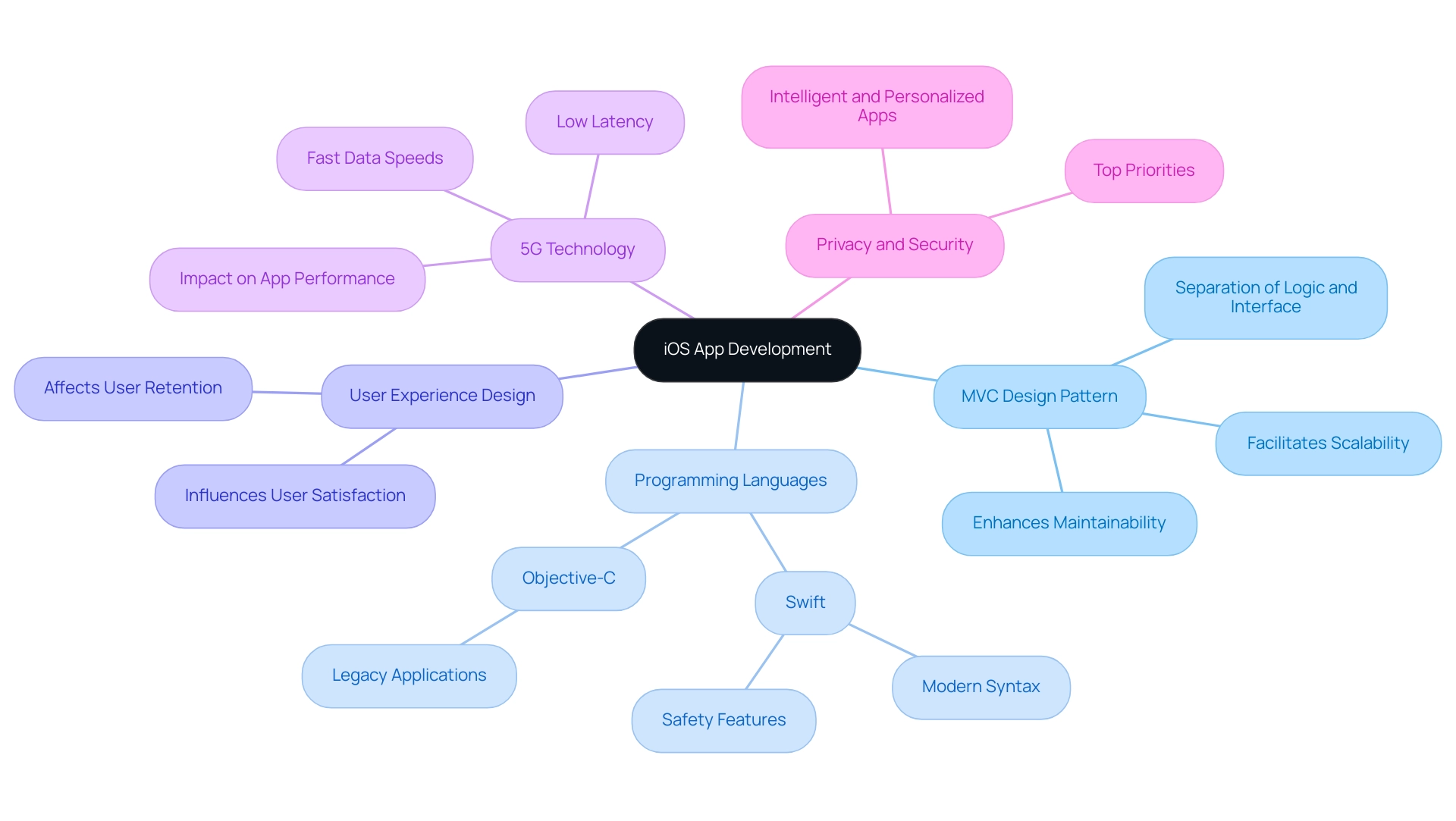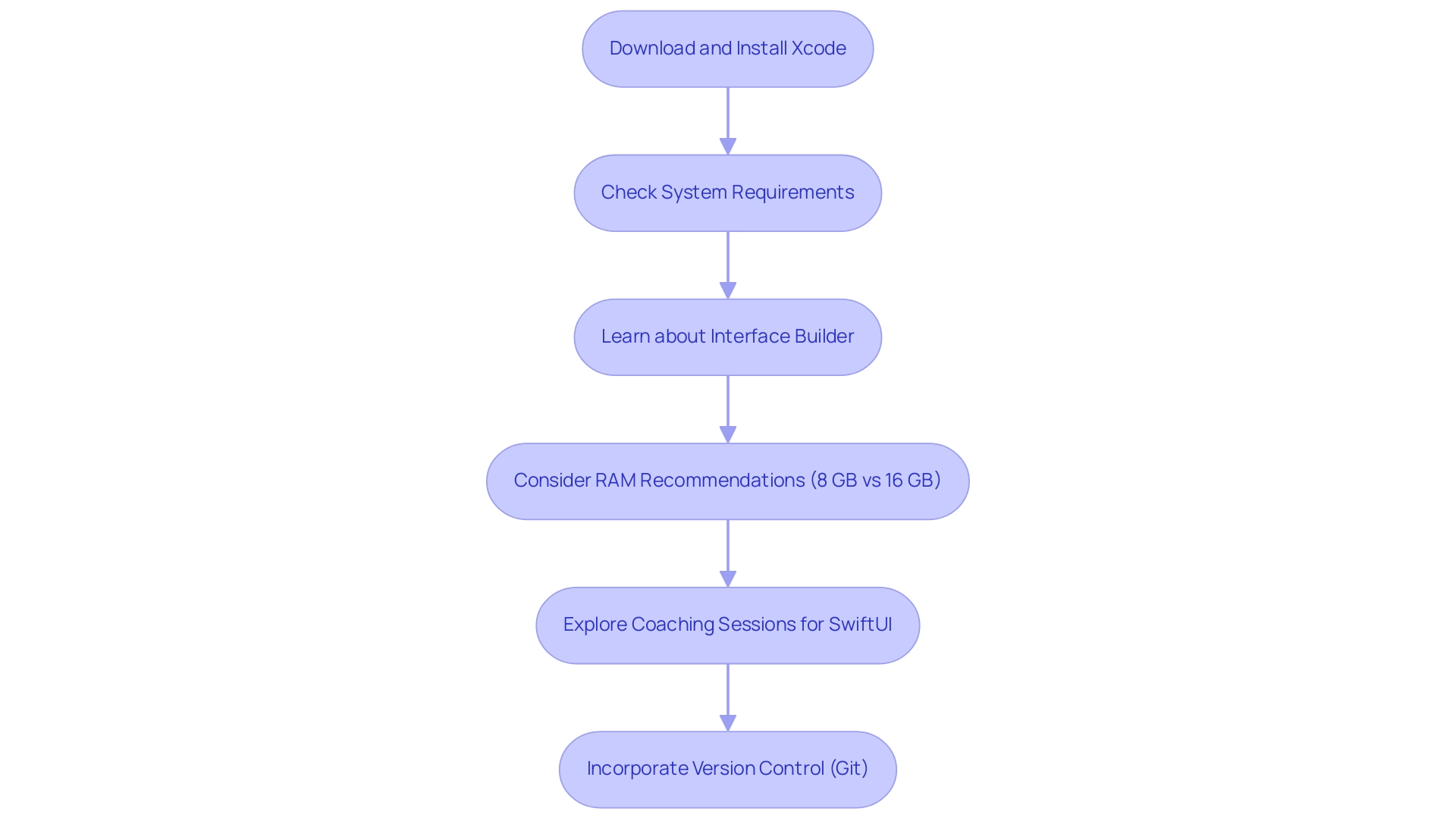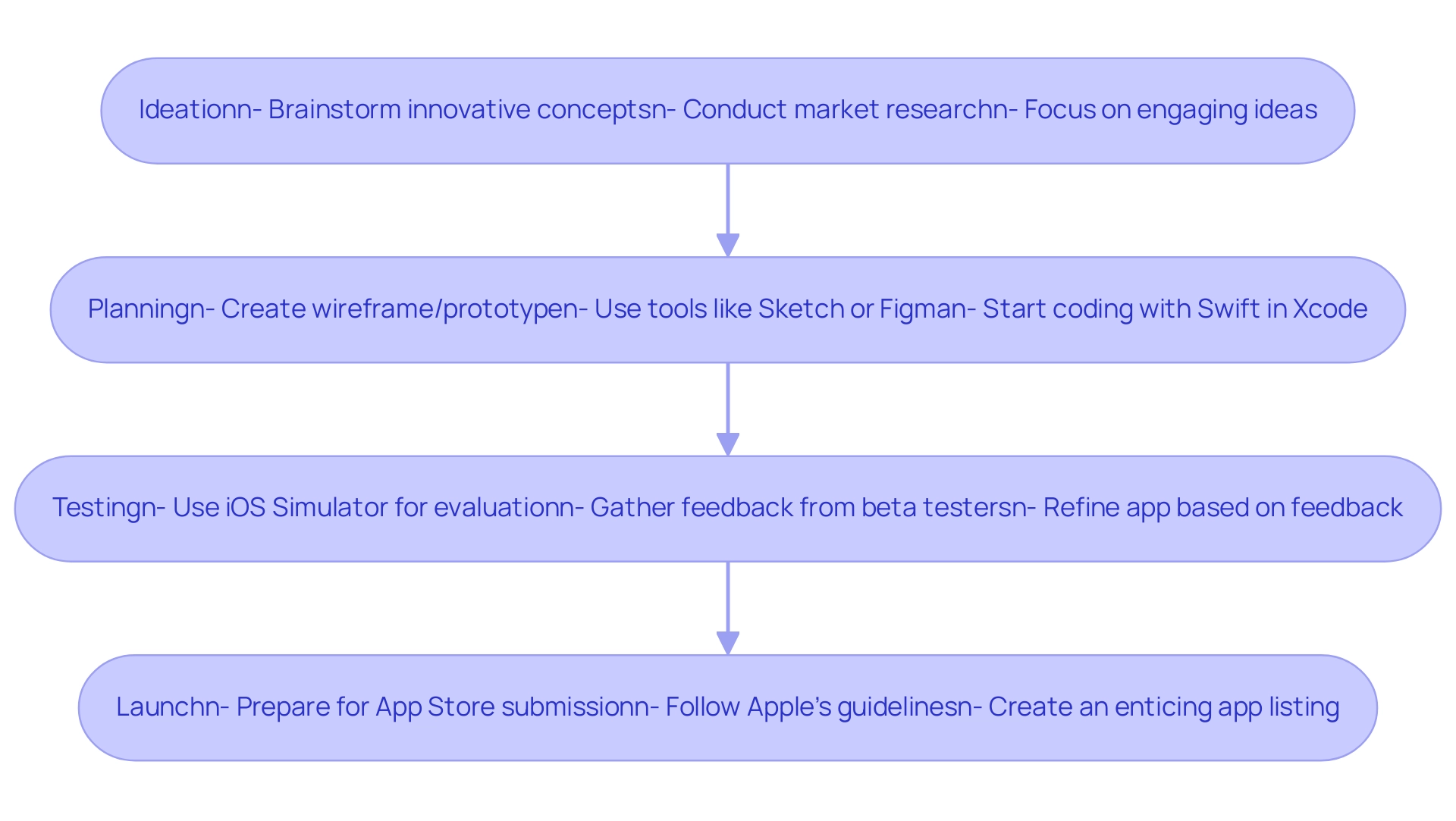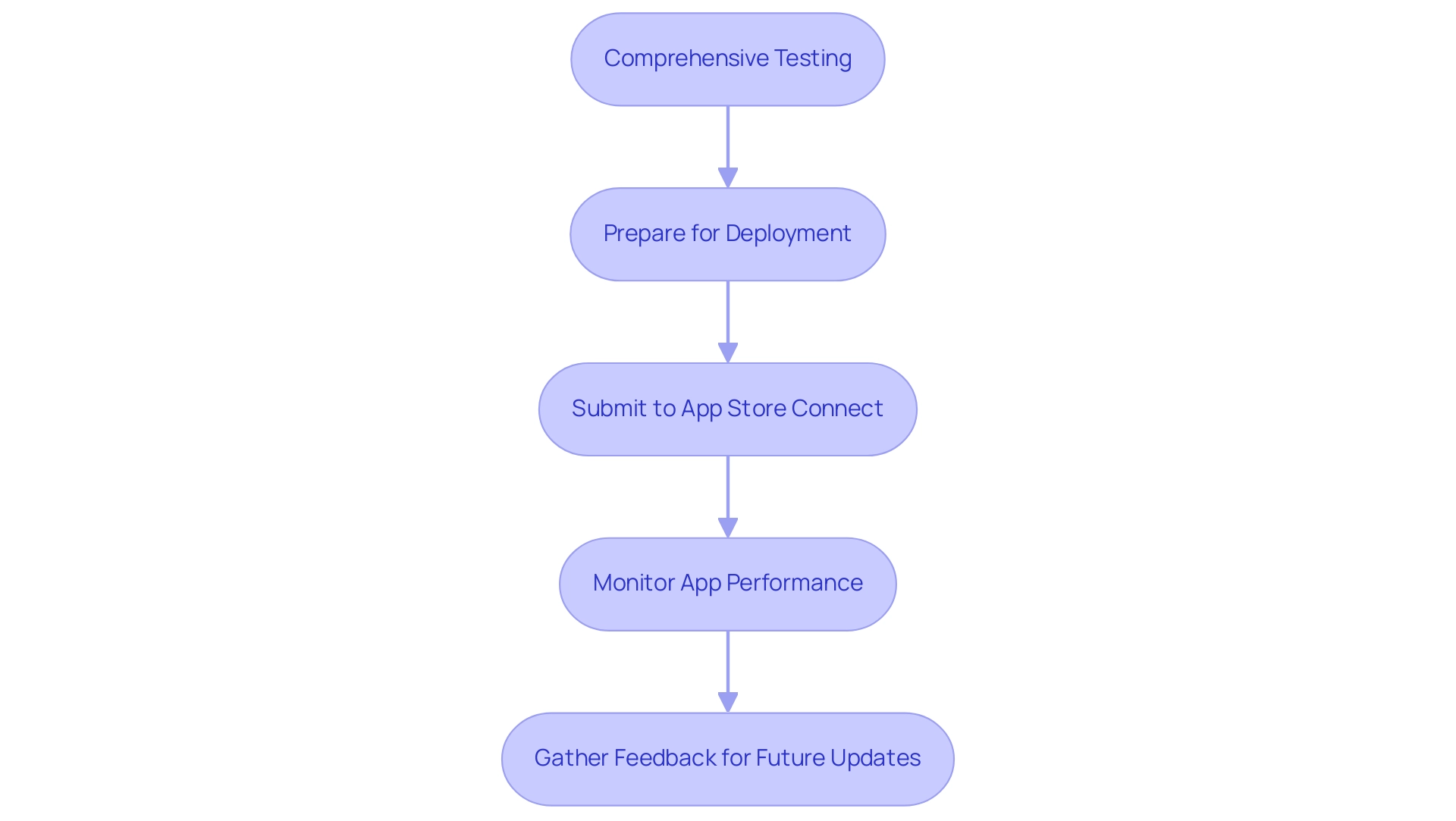Introduction
In the dynamic realm of mobile technology, mastering iOS app development is not just an option; it's a necessity for aspiring developers and established businesses alike. Understanding the foundational principles, such as the Model-View-Controller design pattern and the nuances between Swift and Objective-C, lays the groundwork for creating successful applications.
As the demand for innovative and user-friendly apps continues to surge, developers must navigate various stages—from ideation and planning to testing and deployment—while keeping user experience and performance optimization at the forefront.
This comprehensive guide aims to equip developers with the essential knowledge and tools to thrive in the competitive iOS landscape, ensuring that their applications not only meet but exceed user expectations.
Understanding the Basics of iOS App Development
Before you start iOS app development, it is crucial to grasp the foundational concepts that will guide your process. One of the cornerstones of iOS programming is the Model-View-Controller (MVC) design pattern, which facilitates the separation of application logic from interface elements, enhancing maintainability and scalability. This architecture allows developers to create more organized code, making it easier to manage and update applications as they evolve.
Furthermore, understanding the differences between Swift and Objective-C is essential. Swift, introduced by Apple, offers modern syntax and safety features, which many developers favor for new projects, while Objective-C remains prevalent in legacy applications. Both languages serve distinct roles in the iOS ecosystem, and familiarity with them will empower you to choose the right tool for your specific needs.
According to Sheheryaar Rizvi, an SEO specialist at Graficano communications, "Very informative" insights into these concepts can significantly aid developers in navigating the complexities of app creation. Additionally, it is important to consider that most app developers are expecting an average of 1,000 to 10,000 individuals, which shapes the development strategy. Navigating the iOS ecosystem also entails a thorough understanding of the App Store guidelines and the pivotal role of experience (UX) design.
Prioritizing UX design is paramount, as it directly influences user satisfaction and retention. Moreover, with the integration of 5G technology projected to significantly impact mobile application creation in 2024, developers should optimize app performance for fast data speeds and low latency. By mastering these key concepts, including the critical focus on privacy and security as top priorities, you will be well-equipped to make informed decisions that will benefit your progress and ultimately lead to successful app deployment.

Setting Up Your Development Environment
To start iOS app development, the first step is to download and install Xcode, Apple's leading integrated environment (IDE) designed for MacOS. Xcode comes equipped with the iOS SDK, offering a comprehensive suite of tools and frameworks vital for building robust iOS applications. It's essential to ensure your Mac adheres to the system requirements for Xcode.
Current recommendations suggest that developers should ideally have a minimum of 16 GB of RAM to facilitate smooth operation, particularly for more complex projects. However, a case study reveals that several individuals, including endecotp, affirm that 8 GB of RAM will be sufficient for running Xcode, especially for beginners. This consensus alleviates concerns about hardware limitations when starting out.
As one developer noted, "Wait for the M4 Ultra Mac Studio, if you can afford it. It’s a beast," emphasizing the potential for hardware upgrades for those looking to enhance their programming experience.
Getting to know Interface Builder, a powerful feature within Xcode, is crucial as it allows you to design your app's user interface visually, streamlining the creation process. For those who may need additional guidance, coaching sessions for SwiftUI projects are readily available, providing expert support tailored to your needs. Lastly, incorporating a version control system like Git into your workflow is highly recommended for effective management of your codebase, ensuring a more organized and collaborative experience.
As you start iOS app development using Xcode in 2024, keeping abreast of the latest updates and features will further enhance your productivity and the quality of your applications.

A Step-by-Step Guide to Developing Your First iOS App
-
Ideation: The first step to start iOS app development is brainstorming innovative concepts that address specific needs or solve existing problems. Conduct thorough market research to identify gaps in the app ecosystem; this will ensure that your concept stands out. With 71% of app participants churning within the first 90 days, it’s crucial to focus on ideas that engage individuals from the outset. Consider popular app categories, such as gaming and commercial apps, which have shown higher success rates in the market, as indicated by recent studies.
-
Planning: Once you have a solid app idea, the next step to start iOS app development is to create a wireframe or prototype to visualize the interface and experience. Utilize advanced tools such as Sketch or Figma, which are widely regarded by app developers for their efficiency in wireframing. This planning phase is essential, as it lays the foundation for the app's design and functionality, ensuring a smooth development process. Keep in mind that mobile visitors typically access fewer pages than desktop visitors (2.67 pages on average), so optimizing the experience for mobile is critical. To start iOS app development, you should begin coding your app using Swift within the Xcode environment. Concentrate on building core functionalities first to establish a robust base. Leverage Apple’s extensive documentation and online communities for troubleshooting and guidance. Remember, effective coding practices at this stage can significantly enhance client retention, as increasing retention by just 5% can boost profits by 25-95%.
-
Testing: Testing is a critical component of app development. Utilize the iOS Simulator included in Xcode to evaluate your app across a variety of devices. Gather feedback from beta testers to identify areas for improvement. This iterative process is essential for refining your app and ensuring it meets audience expectations before launch.
-
Launch: As your app nears completion, prepare for its submission to the App Store. Follow Apple’s stringent guidelines to avoid rejection. Create an enticing app listing that includes high-quality screenshots and a compelling description to attract potential customers. A well-prepared launch can set the stage for your app’s success in a competitive market.

Testing and Deploying Your iOS Application
Comprehensive testing is crucial for ensuring the success of your iOS application, encompassing both automated and manual testing strategies. Utilizing XCTest, Apple's dedicated testing framework, allows developers to write effective unit tests, ensuring that every component of your code functions as intended. As highlighted by Shreya Bose, a community contributor, > The average mobile individual checks their smartphone 47 times a day, underscoring the necessity for rigorous testing to meet expectations.
Testing sessions are essential for gathering real-time feedback on usability and functionality, providing insights that can significantly enhance the experience.
When testing is finalized and any identified issues are addressed, the next step is to prepare for deployment. Create an App Store Connect account and meticulously follow the submission guidelines to ensure your app meets all necessary criteria for review. Post-launch, it’s vital to monitor your app’s performance closely, as feedback will be instrumental in shaping future updates and bug fixes.
Adopting a proactive approach to feedback can lead to sustained improvement and satisfaction, ultimately fostering a loyal customer base. For instance, companies like Testlio leverage a network of over 10,000 freelancers to provide mobile app testing services, enabling clients to test their apps on over 600,000 devices across 150+ countries. This extensive testing capability ensures that developers can deliver experiences that resonate with users, highlighting the importance of comprehensive testing strategies in enhancing app quality and significantly impacting user retention and satisfaction. In the current landscape where many aim to start iOS app development, the software developer engagement rate for popular technologies in 2023 is a critical factor to consider, indicating trends that may influence your testing strategies.
Furthermore, staying updated on the latest news regarding iOS app testing frameworks for 2024 is essential for developers to implement the most effective testing methodologies.

Conclusion
Mastering iOS app development is an essential pursuit for developers aiming to succeed in today's competitive mobile technology landscape. By understanding foundational concepts such as the Model-View-Controller design pattern and the differences between Swift and Objective-C, developers can create applications that are not only functional but also maintainable and scalable. The emphasis on user experience, particularly in light of the expected impact of 5G technology, underscores the need to prioritize performance optimization and user satisfaction throughout the development process.
Setting up the right development environment, particularly with tools like Xcode and version control systems, prepares developers for a smooth coding experience. Following a structured approach—from ideation and planning to testing and deployment—ensures that each stage of app development is thoughtfully executed. The importance of rigorous testing cannot be overstated, as it lays the groundwork for a successful launch and long-term user retention.
In conclusion, the journey of iOS app development is multifaceted and requires a strategic approach. By equipping themselves with the right knowledge and tools, developers can navigate the complexities of creating innovative applications that resonate with users. As the demand for high-quality apps continues to grow, those who embrace these principles will not only meet but exceed user expectations, standing out in an ever-evolving digital marketplace.





